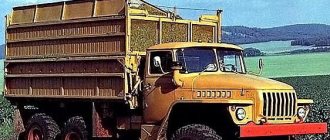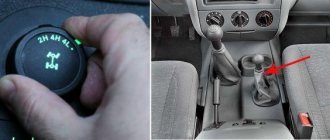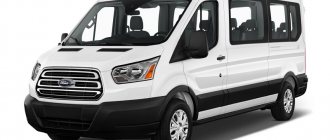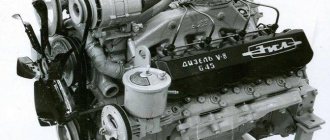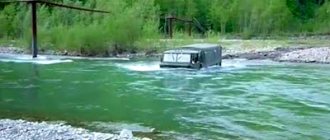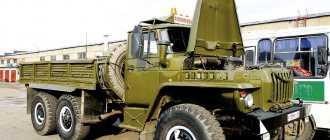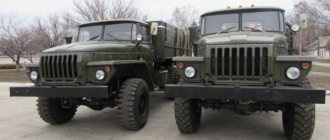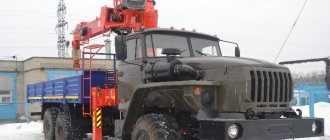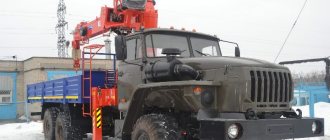We continue the theme of 8x8 cargo all-terrain vehicles. In the previous article about all-terrain vehicles, we discussed the new branded all-terrain vehicle KamAZ-6355 “Arctic”. This Russian all-terrain vehicle is incredibly cool, but 15 million rubles will be a little expensive for some buyers. Need something cheaper? - please, you can already order an 8x8 cargo all-terrain vehicle at a price of around 5 million rubles!
Equipment of the Hurricane 8×8 all-terrain vehicle based on the Ural-4320
The Hurricane 8x8 all-terrain vehicle is produced in Omsk at the TechnoService enterprise. It is built on the meringue of the units of the six-wheeled serial Ural-4320 truck, to which another steered drive axle has been added under the cab. Diesel engines, 230-horsepower 6-cylinder YaMZ-236 or 240-horsepower 8-cylinder YaMZ-238, with a service life of up to 1 million km. The gearbox is five-speed manual, the transfer case is two-speed with a locking central differential. Torque is distributed between the front and rear wheelsets in a ratio of 1:2, while the rear axles are equipped with locking cross-axle differentials. All-terrain vehicle tires - KAMA-1260 have adjustable pressure ranging from 0.5 to 5.5 kgf/cm2.
This new all-terrain vehicle, as its creators describe it, was built in Omsk. Many people dream of creating the best all-terrain vehicle with their own hands, but here we already have a ready-made and relatively inexpensive all-terrain vehicle-swamp vehicle!
All-wheel drive and 44 tons of gross weight: Ural presented a new 8x8 chassis
The Ural Automobile Plant continues to develop its families of off-road vehicles. In addition to the noticeable (though not yet overwhelming) Next hood family in the program, a hoodless range is also being developed. So, quite recently, the assembly line began on the assembly line of a fundamentally new four-axle vehicle Ural-9593 with an 8x8 wheel arrangement with a total weight of up to 44 tons. The load capacity of each of the front axles is nine tons, the rear bogie is 26 tons. The engine is YaMZ-653 with a power of 422 hp. ., gearbox - manual, 16-speed.
This year, however, only seven such chassis will be assembled. All of them will receive crane superstructures from the Chelyabinsk Mechanical Plant and will be transferred to the corporate customer - Surgutneftegaz.
A prototype of a cabover Ural with a plastic cabin
In general, the history of all-wheel drive Miass four-axle vehicles is rich and complex and began more than half a century ago. In the mid-1960s, NAMI and the Ural Automobile Plant began developing multi-purpose cabover off-road trucks - of course, commissioned by the USSR Ministry of Defense. By 1972, two prototypes of the Ural-395 8x8 appeared, equipped with an experimental YaMZ-741 (V10) diesel engine with a power of 260 hp. The first was equipped with a plastic cabin, the second with a metal cabin of its own design.
But Soviet unification made itself felt: development under the military code “Susha” continued, only using the KAMAZ cab. In 1979, six vehicles with different units, including YaMZ-741 and KAMAZ-7403 diesel engines, entered military testing.
The Kamaz cab did not fit well with the Ural chassis, and there were problems with the engines
As a result, it was the car with the KAMAZ engine that went into production in 1989, which received the Ural-5323 index and a total weight of 22 tons. It was equipped with a five-speed gearbox, a two-stage transfer case, a balancer suspension and a tire inflation system. However, due to the cabin (also from Kamaz) not being very suitable for the chassis and the lack of new engines, it was produced in small batches.
The first sample with an IVECO cab (the Italian digital indices are still visible on its doors)
There was also an attempt to produce diesel engines for the Urals in Kazakh Kustanai - for this purpose, in 1978 they bought licenses for German Magirus KHD F8L engines (V8, 232 hp). Slow construction of the plant began in 1982, and the production of the first engines began in 1990. And the next year the USSR collapsed - and assembly stopped after the production of 400 engines. Two years later, the plant producing KAMAZ engines burned down, and we had to look for a replacement.
In 1993, versions appeared with the Yaroslavl YaMZ-238B diesel engine with a turbocharger capacity of 300 hp. and eight-speed manual transmission. And two years later, the Ural-5323 received its familiar appearance thanks to the cabin from the Italian IVECO TurboTech. However, it went into wide series only from the beginning of the new century.
There were also several upgrades. Thus, thanks to independent suspension on semi-elliptical springs and strengthening of the frame and rear bogie, 6323 vehicles appeared with a load capacity increased to 18.6 tons. Although these vehicles cannot be called particularly widespread, over twenty years they have mastered many “professions” - from a fire tank to an armored water cannon.
And now the all-wheel drive has become “heavier” to 44 tons of total weight (of course, not road, but technical). Which is understandable, since its main purpose is to work off public roads.
Configurations of the Hurricane 8×8 all-terrain vehicle on Ural-4320 units
The manufacturer’s website states the following configurations of the Hurricane 8×8 all-terrain vehicle:
| price | |
| Chassis | RUB 3,500,000 |
| Timber truck | RUB 3,700,000 |
| Truck tractor | RUB 3,800,000 |
| Gasoline tanker | RUB 4,200,000 |
| Rotation bus | 5,000,000 rub. |
| Onboard manipulator | RUB 5,800,000 |
All equipment is certified for public roads. It is possible to manufacture to order - a dump truck with a lifting capacity of 14-15 tons, a crane, a drilling rig. Cabin options are two-door with 3 seats, four-door with a sleeping bag or four-door with 6 seats, and also combined with a motorhome interior. The truck can be made on an extended or reinforced frame.
Production difficulties
The Ural-5323 army cargo all-terrain vehicle is a four-axle vehicle that first rolled off the assembly line in 1989. From this date it is considered to be the beginning of mass production of this model. Despite the fact that it received a positive assessment from military experts, it was not possible to establish stable serial production of the car. The reason was the difficulty of installation, which was not suitable for the production of a chassis together with a cab from KamAZ. This resulted in the car being produced very slowly. In addition, problems constantly arose due to a lack of engines.
At the beginning of the next decade, the plant plans to begin production of Ural-5323 units with diesel engines from the Kustanai plant. The plans are not destined to be translated into reality. This is hampered by the collapse of the Soviet Union.
At the beginning of 1993, the situation at the plant was improving, and car production continued. But everything comes to an end after a fire at a motor plant in Naberezhnye Chelny, which destroyed all the workshops. Only by the beginning of next year does a way out appear. All-terrain vehicles are adapted to the YaMZ eight-cylinder turbocharged engine.
Motorhome based on the Hurricane 8×8 all-terrain vehicle
The offer from the Omsk company is interesting. For comparison, you can get acquainted with the Ekaterinburg six-wheeled motorhome “Burlak” worth 9 million rubles. The Omsk Uragan motorhome from TechnoService costs much less. It is designed to carry 10 people. In the warm interior of the motorhome there are 4 sleeping places, an additional heater and a wood (!) stove, so as not to burn diesel fuel in winter. This is an affordable all-terrain vehicle, but only for hunting and fishing, but also for a long winter!
The interior decoration of the living compartment can be viewed in the video. It does not look like the furnishings of a modern high-tech campervan with all the amenities, but rather like... a Russian hut with beds and a fireplace. However, modern “furniture” in a “hut” is a profitable business. But the Hurricane has an exclusive feature - an open body, which can be entered directly from the cabin. It contains two 450-liter fuel tanks and a spare wheel with a built-in lowering mechanism.
This kind of motorhome on wheels can be made to order from the Hurricane 8x8 all-terrain vehicle. And this is not a homemade motorhome, but a new and exclusive motorhome from the manufacturer!
Specifications
The Ural-5323 vehicle, the technical characteristics of which have changed more than once throughout the history of production, has proven itself well as a reliable and unpretentious off-road cargo all-terrain vehicle. The first models were equipped with engines from Naberezhnye Chelny and the same cabins. After some time, the plant management decides to install the YaMZ-238-B power unit, as well as the YaMZ-7601.
In 1995, the Ural-5323 was equipped with an imported IVECO cabin with improved comfort for the driver and passenger. Many years of practice have shown an advantage over the domestic version and served as a development for the further use of Italian components.
Truck URAL 4320 - reviews
vadas
https://otzovik.com/review_1032110.html
Advantages:
- Maintainability
- unpretentiousness.
Flaws:
- Too uncomfortable in the cabin.
- The original herringbone tires are too noisy when driving on asphalt.
I first became acquainted with this car while serving in the army. True, the first car still had a gasoline carburetor engine with enormous “gluttony.” But I liked the car right away because of its cross-country ability. Later there was the same car only with a YaMZ-236 engine. Six-cylinder diesel engine from the Yaroslavl Motor Plant. During the entire period of use, there were no complaints. The engine is of very high quality, easy to operate and repair. The presence of a downshift and the ability to change the tire pressure from the driver’s cab are also very pleasing. The car is also very convenient when unloading, it rolls out on three sides. The only thing that upsets me is changing the tire when I get a puncture, it’s very difficult.
sanek2009
https://otzovik.com/review_5553484.html
Advantages:
- Reliability.
- Simplicity.
Flaws:
- Brakes.
- Weak bridges.
I have owned this Ural4320 vehicle with a YaMZ 238 diesel engine (240 hp) for 4 years and I can say with 100% confidence that the Ural4320 is a powerful and passable vehicle compared to similar KamAZs and all sorts of Zils. It is completely repairable, does not require any extra special knowledge about the structure of the car, everything is simple and clear. The prices for spare parts are quite affordable and do not suffer from shortages (they are always in stock in stores). The main disadvantage is pneumatic-hydraulic brakes, which are like a roulette today and disappear tomorrow for unknown reasons. The main advantage is the reliability of the engine.
Slava290691
https://otzovik.com/review_4798042.html
Advantages:
- high cross-country ability
- Availability of automatic tire inflation
- high maximum load.
Flaws:
- relatively finicky engine
- Repairing some components and assemblies requires a lot of physical strength.
Overall the car is not bad but the engine leaves much to be desired. He's very picky. This is especially true for the rubber pipes of the fuel system, which leak every now and then. It’s also not uncommon for a low-pressure fuel pump to fail; the fastening “ears” are very fragile; just slightly tighten the nuts and the fastening simply bursts.
Starting up in winter is also very difficult, especially without a heating boiler. As for me, this car is more suitable for the more durable YaMZ 236.
As for the chassis, I can’t help but note the high cross-country ability of this car, but as for dismantling the wheels, this is a very difficult task since it requires a considerable amount of physical strength and skill, since the wheel itself has a lot of weight and the disassembly method is almost “individual” to each wheel, especially if it has not been disassembled for a very long time, often the problem when disassembling the wheel is the flipper sticking to the disk or getting caught by the disk.
Soldier
https://truck.ironhorse.ru/ural-4320.html?comments=1
I drove one of these in the army when I did my military service. The engine is diesel, very high-torque, but you won’t be able to accelerate on the highway in such a car - the most optimal speed is 60 km/h. In fact, it is designed for off-road use - when you start locking and all the bridges are “rowing” - nothing can stop it.
Alexander
https://truck.ironhorse.ru/ural-4320.html?comments=1
In principle, the truck is not bad, but there are always some problems with the engine. He's too capricious. The weakest point is the rubber pipes of the fuel system. No matter what I do with them, they still leak. The fuel pump is also not all right - it regularly breaks down. The mounting “ears,” by the way, are too fragile: if you slightly tighten the nuts, the fastening will burst. Starting the engine in winter is not at all easy (without a heating boiler it is almost impossible). In my opinion, the Yaroslavl engine, YaMZ-236, is more suitable for the Urals. It is both more reliable and durable. I don't like the braking system either. The problems with her are through the roof. It breaks down all the time - just have time to repair it. As for the cabin, being in it is, to put it mildly, uncomfortable. It is very cramped and simple to the point of disgrace. I feel much better in Kamaz. Dismantling wheels is a separate issue. Not only are they very heavy in themselves, but you also have to look for an “individual approach” to each of them. Well, what the car can be praised for is its cross-country ability. In order for it to get stuck somewhere, you need to try hard. Personally, I “crawled” out of any mud behind the wheel of this truck.
Konstantin
https://avto-russia.ru/autos/ural/ural_4320.html?part=review
The Ural has many more advantages than disadvantages. There are weak points in any car. The main thing is who needs what. The Ural is a strong and fairly reliable vehicle and its cross-country ability is not bad, especially with the 236 engine. The problems that I had to face, as I understand it, are typical for him - the steering gear, the transfer case. And now the brakes require attention. They disinhibit poorly. The cross-country ability of the Ural 4320 is amazing, and the fuel consumption is the same as that of the GAZ-66, the mileage without refueling is twice as much as that of the GAZ, and there were practically no breakdowns during the entire period of operation, nothing serious except torn off inflation hoses. The car turned out to be very reliable and did not let us down, however, when I took it back from storage, I went through it completely, changed all the oil seals and some bearings in the hubs due to rust, the 1989 car was taking its toll.
Advantages:
- reliability.
- Patency.
Flaws:
- steering gear.
- Handout.
Swarilight
https://otzyv.expert/suroviy-avtomobil-dlya-surovih-dorog-680853
Advantages:
- Patency.
- Maintainability.
- Good engine.
Flaws:
- Lack of amenities.
Details
I currently have three of these cars at my disposal. Previously, they were equipped with an engine from KamAZ. Not the best option. In recent years, the car has been equipped with YaMZ engines. The motor is good. The best thing about this car. The chassis is also good. Cross-country ability is excellent. I don't like the gearbox. There are problems with her. The brake system sucks! Constantly breaks down. The steering isn't the best either. Problems arise periodically with the power steering. Constant problems with electronics, light bulbs and fuses. Problems rarely arise with a heating boiler. They are mainly associated with the Injector. In general, the car is easy to repair. If, of course, you know how it's done.
There is nothing to write about comfort. It's simply not there. Driving in KamAZ is much more pleasant, there is much more space.
The Ural is a workhorse. Overall the car is good. The whole army is traveling.
Slowerness
https://otzyv.expert/dizelniy-titan-1140828
Advantages:
- Unpretentiousness
- simplicity
- cross-country ability
- maintainability
Flaws:
- Pneumohydraulic brakes
- cramped cabin
- mediocre visibility from the cockpit
Details
The army had the opportunity to operate two Urals-4320 with an APA-5D installation (actually a generator for powering the on-board systems of aircraft), and the vehicles differed in age and power units: one from 1991 with a KamAZ-740 diesel engine, the second from 2006 with a YaMZ-238M2.
The Ural is a spartan truck; the only amenities in its cabin are three seats and a roof over your head. My height is about 187 cm, I fit quite comfortably in the driver's seat. The controls for all sorts of systems are archaic, the instruments are standard for many Soviet vehicles, the gearshift lever sticks out a good half meter from the floor. The older car (hereinafter referred to as car No. 1) has a very specific pneumatic drive for the windshield wipers - you unscrew the valve on the panel little by little and nothing happens, turn it further, and a demon takes possession of the wipers - they fly like crazy. We need to get used to it. The steering is power-assisted and the huge wheels turn without much effort. First and reverse gears do not have synchronizers, so you either have to wait a little after depressing the clutch and engage, or engage immediately with a crunch, or first engage the synchronizer in some other gear, and then engage reverse/first without any problems or effort.
To the right of the gearshift lever, two more levers grow from the floor: one controls the transfer case (low-neutral-high), the second is responsible for locking the center differential. Yes, yes, contrary to the opinion of many, the 4320 model has permanent 6x6 all-wheel drive. On car No. 1, another small lever inconveniently stuck out of the floor to the right, which turned on the power take-off from the transfer case to drive the generator of the electrical installation; on car No. 2 it was replaced by a pneumatic crane.
The cabin is narrower than on a KAMAZ or MAZ; sleeping full-length in it is not so comfortable. %) But the stove heats well, and for ventilation there are both rotary windows and completely lowered side windows.
I really didn’t like the pneumatic-hydraulic braking system, it doesn’t provide any advantages, it doesn’t work without air, but it also requires a large amount of brake fluid. This is some kind of stupidity, ZIL, MAZ, KAMAZ and KrAZ get by just fine with a conventional pneumatic drive. The handbrake in the Urals is transmission; there is a brake drum on the cardan shaft after the transfer case - not as reliable as energy accumulators, but it works.
Now about diesels. Both are naturally aspirated, the 740 develops 210 hp. s., 238th 240 l. s., both have a V8 layout. Since the Yaroslavl engine has a larger volume and size (and weight), its installation required lengthening the hood. It is worth noting that it is more convenient to service - there is good access to the units, there is a lot of space, the Kama engine has a more dense layout. The Ural with the YaMZ-238 reminds me of a diesel locomotive or an icebreaker, the engine pulls so confidently. But as
sounds! ... The Kamaz diesel requires more revolutions and runs worse in cold weather, in general it is more temperamental and runs normally at higher speeds (1400-1700 rpm), its exhaust smells different from the Yaroslavl one. :) If necessary, you can fill in kerosene for a while, after adding a certain amount of motor oil to it; both diesel engines do not react in any way to changing the fuel. Just the main thing is not to get carried away!
The YaMZ diesel engine was equipped with a pre-heater, which I used only once, because oil dripped onto its boiler from the hydraulic coupling of the cooling fan drive. The boiler gets very hot during operation, so the oil began to smoke, I felt uneasy and I stopped this matter.
Car No. 2 had higher cross-country ability due to the presence of pneumatic locking of the cross-axle differentials of the middle and rear axles; the valve is located on the panel next to the valve for turning on the power take-off from the transfer case. On car No. 1, I once found myself in an interesting situation: while towing a trailer along the airfield to make a sharp turn, I decided to drive the Ural into the snow so that the trailer with the blades would pass along the cleared taxiing area. It broke through the snow parapet and the front axle found itself in the snow up to the running board, while (the turn was to the left at an acute angle) the right wheels of the rear cart also ended up in the snow, and the left rear wheels were on the hard-rolled slippery steering wheel. The car stopped, the locking of the center differential did not help - one wheel of the front axle was spinning idle in the snow, and the left rear wheels were happily grinding the steering - it was not even possible to rock it, it was so slippery. The ZIL-131 UKS and shovels came to the rescue; the ZIL had to pull my Ural several times, because it was also desperately sliding. In car No. 2, I think I would have left on my own.
In the Urals there is a centralized tire inflation system, which I used twice only to inflate a flat tire. To be able to regulate tire pressure, you need to open special valves on all wheels with a tetrahedron.
The older car No. 1 had a standard two-pipe pneumatic signal, with which I once greatly frightened one warrior. :) On car No. 2 the standard signal was electric, consisting of two snails. Typically, the signal is activated by a button on the floor under the left foot, which is very inconvenient. Sometimes it becomes necessary to honk the horn with the clutch depressed when, for example, you are slowly reversing among people. For some reason, there are individuals who are not at all frightened by the prospect of falling under the Urals - they climb like cockroaches...
The view from the cabin is severely limited by the long hood; if a person of average height approaches the right headlight, then he cannot be seen from the driver’s seat! On cars with YaMZ, the air filter housing on the right wing also interferes.
But in case of repair or maintenance, the Ural is quite convenient - the hood layout and high ground clearance, you can easily get to the desired unit almost everywhere.
In general, I remember the Urals with warmth.
Military vehicles
Since off-road trucks of this modification were mainly produced for the needs of the army, a whole line of models was created intended for such use:
- "Ural-532303" is the first domestic armored cargo vehicle.
- REM KL is a repair and recovery truck.
- "Avalanche Hurricane" - water cannon.
- "Pantsir-S1" is an anti-aircraft gun missile system.
- TOR M1TA - anti-aircraft missile system.
- MSTA-K is a self-propelled howitzer.
- SKO-10K is a station for the purification and preparation of drinking water.
- PP-91 and PP-2005 are vehicles for the pontoon fleet, used to create mobile crossings.

